
20/F, Building 5, Yard 1, Yuetan South Street, Xicheng District, Beijing China Code:100033
Tel: 010-68063910 Fax: 010-68066630
Copyright 2004-2017 All Rights Reserved. China Trustee Association
京ICP备 19023601号

In 2017, Chinese economy witnessed a favorably steady increase and reached a new high, representing a robust performance. The GDP reached a new high to 82.7 trillion Yuan, with an increase of 6.9% YoY, compared with a 6.7% in 2016. Among the industries, added values increase by 3.0% YoY for the primary industry, 6.4% YoY for the secondary industry, and 7.7% YoY for the tertiary. Main business data of trust companies released by China Trustee Association (CTA) have shown that the growth rate of the trust industry coordinated pace with that of the Chinese economy, with the size of assets continuing to grow, albeit at a relatively lower rate. Confronted with the transformed macro economy pattern and reinforced regulations, the trust industry is expected to take active yet prudent steps in optimizing the present module of operation and management, and trust companies to cultivate the core competency and shift toward intensification and innovation. Meanwhile, participants in the industry should also promote the innovation of corporate governance, stick to the bottom line of compliance management, return to the nature of trusteeship, and provide better service for the real economy, all of which shall in turn fuel transformation and sustainable development of the industry.
I. Continued Growth of Trust Assets and Expanded Size of Proprietary Assets
A. Trust Assets
As of the end of 2017, the trust assets under management of 68 trust companies topped 26 trillion yuan, reaching 26.25 trillion yuan (38.57 billion Yuan per company on average) with a quarterly increase of 7.54%. At the end of 2017, the size of trust assets grew at a YoY growth rate of 29.81%, and increased by 5.8% from that of 2016. The YoY growth rate of the trust asset began to recover after touching its historical low in 2016 Q2 and witnessed a 2.07% increase in 2017 Q4 from 5.47% in the previous quarter.
The growth of the scale of trust assets was inextricably linked with the macro economy. In the second half of 2016, with the advance of supply-side structural reform, demands in consumption and investment have been driven up, which have further picked up the GDP with a momentum of growth. Also, bolstered by the sound economic fundamentals, the YoY growth rate of the size of trust assets steadily ascended.
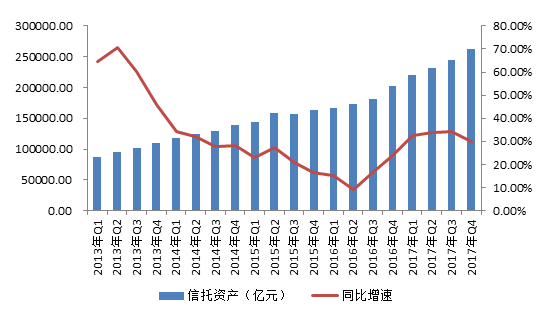
Chart 1: Size of trust assets and quarterly growth rate from 2013-2017
In terms of sources of assets, while the share of single fund trust showed declining, shares of collective pecuniary trust and the property trust increased steadily. By the end of 2017, the share of single fund trust decreased by 4.34 percentage points from 50.07% to 45.73%, compared with that of 2016; the share of collective pecuniary trust rose by 1.46 percentage points from 36.38% to 37.74%; the share of property trust rose by 2.88 percentage points from 13.65% to 16.53%. These figures imply an improvement in the diversity in the sources and equilibrium of the shares.
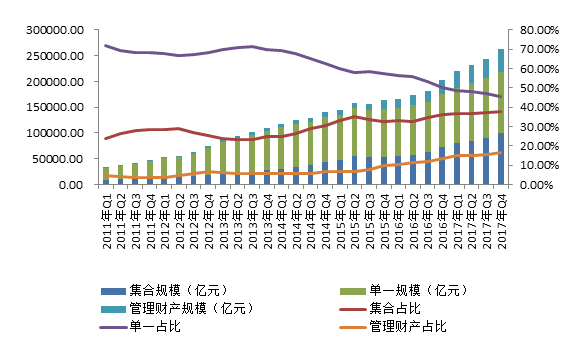
Chart 2 Changes in the source of trust assets from 2011-2017
B. The Proprietary Assets and Equity
As of the end of 2017, the proprietary assets in the trust industry reached 657.899 billion Yuan, (9.765 billion Yuan per company on average) with a YoY growth rate of 18.12% and a quarterly growth rate of 3.69%, which suggested a steady and upward trend despite a lowered YoY growth compared with 2017 Q3 (25.88%). In terms of structure, investment assets remain the major form of proprietary assets, which amounted to 496.1 billion Yuan, accounting for 75.41% of total proprietary assets. Money assets amounted to 65.68 billion Yuan, accounting for 9.98% of total. Assets of loans amounted to 38.07 billion Yuan, only accounting for 5.79% of total.

Chart3: Changes of the proprietary assets from 2011-2017
As of the end of 2017, the owner’s equity of the trust industry totaled 525.07 billion Yuan, (7.72 billion Yuan per company on average) with a YoY growth rate of 16.63% and a quarterly growth rate of 5.10%. In terms of components, paid-in capitals accounted for 46.05% of total owner’s equities, which increased by 0.78% compared with that of 2016. Undistributed profits accounted for 29.52% of total, which declined by 0.03%. Trust compensation reserve funds accounted for 4.21% of total, which increased slightly by 0.06%.
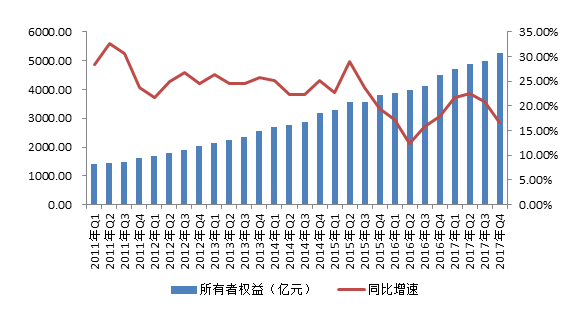
Chart4: Changes in the owner's equity from 2011-2017
Changes in the growth and component of the owner’s equity suggest the intention and efforts of risk control of trust companies. By the end of 2017, the paid-in capital of the trust industry rose by 18.62% YoY and by 8.22% quarterly, hitting 241.77 billion Yuan. Undistributed profits rose from 133.05 billion Yuan to 155.00 billion Yuan, with a YoY growth rate of 16.50% and a quarterly decline of 0.62%. Trust provision reached 22.11 billion Yuan, with a YoY growth rate of 18.23% and a quarterly increase of 12.78%. The continued growth of paid-in capital was the direct results of the continuous increase in capital and share among trust companies in recent years, and the expansions of undistributed profits and trust compensation reserve fund helped the enhancement of risk-resistant abilities.
C. The Amount and Scale of Projects at Risk
As of the end of 2017, 601 projects of the industry were at risk and this number was 56 more than that of 2016, and was 7 more than that of the previous quarter. The balance of projects at risk was 131.43 billion Yuan., which increased by 11.82% YoY from 117.54 billion Yuan in 2016, and dropped by 5.61% on a quarterly basis from 139.24 billion Yuan in 2017 Q3. Though the risk assets ratio extended a downward trend and the figure was 0.50% by the end of 2017, with a YoY drop of 0.08 percentage point and a quarterly declined of 0.07 percentage point, the number of balance of projects at risk appeared a clear upward trend, which could not be neglected. Collaborated with other financial participants, under the guidance of the supervisory authority, trust companies are expected to enhance their risk awareness, improve efficiency of risk control to take diversified methods to ensure that no systemic financial risks occur.
II. Business Performance Improved with Optimized Structure
A. Business Performance
The overall business performance of the trust industry in 2017 witnessed a steady improvement. The income of the trust industry amounted to 119.07 billion Yuan, which represented a 6.67% YoY increase from 111.62 billion Yuan in 2016. The profit of the industry amounted to 82.411 billion Yuan, which represented a 6.78% YoY increase compared with that of 2016. When compared with the previous quarter, both the total income and the total profit have seen an increase, 57.43% and 48.81% respectively, which were partially due to the seasonal effect. According to the historical record, the third and fourth quarters usually achieved relatively higher business income and profit than the first and second quarters, leading to notable fluctuations in the measurement on a quarterly basis.
In terms of components of business income, the proportion of income from trust business remained the core momentum for the boosting business income. By the end of 2017, the income of trust business amounted to 80.52 billion Yuan, accounted for 67.62% of total income and increased by 7.41% YoY and by 51.96% quarterly. Investment gains was 28.49 billion Yuan, accounted for 23.93% of total income, increased by 5.24% YoY and by 74.01% quarterly. Interest income was 6.24 billion Yuan, accounted for only 5.24% of total income, and decreased by 0.60% YoY though improved by 55.28% from the previous quarter. As trust business is the pillar of trust companies and with the updating of the industry marked by the call of returning to the nature of trust, income of trust business and its proportion are expected for a continuous boosting.
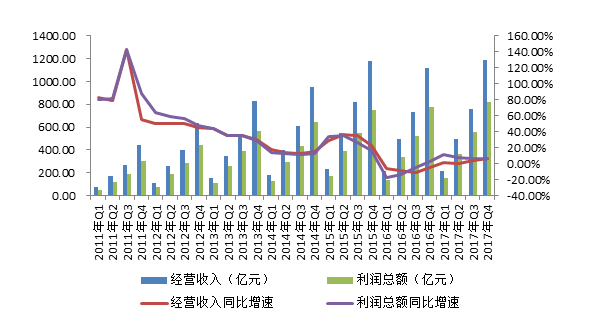
Chart 5: Changes in quarterly incomes, profits, and growth rate
B. Performance of Trustee Management
In December 2017, 2029 trust projects were liquidated, and by the end of 2017, the comprehensive annual return rate for the beneficiary was 9.42%, which was 1.82 percentage point higher than that of 2016 and 3.57 percentage point higher than that of 2017 Q3. The comprehensive average annual return rate was 0.42%, which declined compared with that of both the previous year and the previous quarter, 0.31 percentage point and 0.02 percentage point respectively. Benefited from the revitalized GDP and the economic progress with improved stability and steadiness, trust business showed good performance; yet on the other hand, trust companies seemed to be lopsided in management with enlarged business size, which led to a comparatively low return rate.
III. Industrial Transformation and Upgrading with Real Economy as the Key
In terms of areas of trust funds, industrial and commercial enterprises remained the largest share contributor of trust fund, financial institutions at the second place and followed by basic industry, securities investment and real estate industry. Proportions of the five major areas in 2017 were as followed: industrial and commercial enterprises accounted for 27.84%, financial institutions 18.76%, basic industry 14.49%, securities investment 14.15% and real estate industry 10.42%. Compared with the statistics of late 2016, a change occurred that basic industry exceeded securities investments and came to the third place.
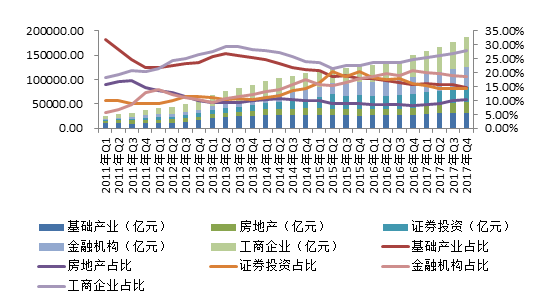
Chart 6: Changes in the shares and trust funds invested in different Areas from Q1 of 2017 to Q4 of 2017
A. Industrial and Commercial Enterprises
Industrial and commercial enterprises have been the largest area of trust investment since 2012 Q2. As of the end of 2017, industrial and commercial enterprises investments amounted to 6.10 trillion Yuan, increased by 40.78% YoY from 4.33 trillion Yuan, and increased by 9.65% on a quarterly basis from 5.56 trillion Yuan in the previous quarter. It accounted for 27.84% of total, 0.89 percentage point higher than that of 2017 Q3. The continuous enlarged size of trust investments to industrial and commercial enterprises had direct impacts on supporting the development of real economy.
B. Financial Institutions
As of the end of 2017, trust investments in financial institutions amounted to 4.11 trillion Yuan, increased by 13.69% YoY from 3.62 trillion Yuan, and increased by 5.15% on a quarterly basis from 3.91 trillion Yuan in the previous quarter. These investments took up 18.76% of the whole, 0.17 percentage point lower than that of 2017 Q3. Since 2017, with tightened supervision and the deleveraging, investments into the financial institutions are expected to be downsized and a trim in the momentum is possible.
C. Basic Industry
As of the end of 2017, trust investments in basic industry amounted to 3.17 trillion Yuan, which accounted for 14.49% of total. It increased by 16.27% YoY from 2.73 trillion Yuan, yet increased by 1.06% on a quarterly basis. Still, basic industry kept its position as the third largest area of trust assets allocation.
D. Securities Market
As of the end of 2017, trust investments in securities market amounted to 3.10 trillion Yuan, which accounted for 14.15% of total, slightly lower (0.18 percentage point) compared with that of 2017 Q3. It increased by 9.57% YoY from 2.83 trillion Yuan, and increased by 4.83% on a quarterly basis from 2.96 trillion Yuan in 2017 Q3. Since 2016 Q1, the proportion of trust investments in securities market appeared a clear downward trend. It bounced back slightly in 2016 Q2, but had a limited impact. The range and depth of trust’s intervention in the securities market will have certain fluctuations in the short run.
E. Real Estate Industry
As of the end of 2017, trust investments in real estate industry amounted to 2.28 trillion yuan, which accounted for 10.42% of total, slightly higher (0.41 percentage point) compared with that of 2017 Q3. It increased by 59.69% YoY from 1.42 trillion Yuan, and increased by 10.50% on a quarterly basis from 2.07 trillion Yuan in 2017 Q3. In recent years, the regulatory policy kept imposing high pressure on real estate financing. It can be expected that growth of trust funds flowing to real estate industry will slow down.
IV. Opportunities and Challenges: Returning to the Nature of Trust
As was made clear in the 19th CPC National Congress in October 2017, quality should be put first and performance is prioritized in building a modernized economy given the fact that China’s economy is transitioning from a phase of repaid growth to a stage of high-quality development. Later in December, at the Central Economic Work Conference, the call for a tightened financial regulatory system to prevent systematic risks was echoed and the opinion that finance should better serve the real economy in the process of deepening reform was shared. In the meantime, profound changes are taking place in the trust industry, as manifested in regulation policies, management environment, competitive landscape, business modules and risk portfolio.
In 2017, Measures of Trust Registration was issued, with which, a registration mechanism was set up in the trust industry and its standardization and transparency have been greatly improved. In the meantime, with a torrent of investigations and regulations by the supervisory authorities, a rash of misconducts have been cleaned up, purifying the cloudy air in such areas as real estate trust, government collaborated trust, the so called “channel business”, etc. In response to these campaigns, most trust companies, by means of increasing capitals and shares, were proactively involved in business transformation and innovation for a stronger risk resisting capability.
In 2017, with reference to the guidance of returning to the nature of trust, trust companies embarked on business transformation. Given the massive changes in industrial structure and consumption patterns, trust companies have made great efforts in diversifying their services. Compatible services such as loan-equity combined investment, asset securitization, industry investment funds, consumption trusts, charity trusts, green trusts, etc. were provided to meet the needs of the real economy and the trust industry itself. In turn, the management capabilities of the trust companies have been greatly improved.
Looking into the year of 2018, the trust industry should promote business transformation with the real economy as the key, stick to the bottom line of compliance with sharpened management skills, and return to the nature of trust. These measures, if fully implemented, shall achieve a robust development of the whole industry.
A. Optimizing the Allocation of Resources in the Real Economy, Transferring Toward Pillar Industries
While significant part of trust resources was allocated to the infrastructure, real estate and the traditional manufacturing industry, the support of the trust industry to the real economy is still far from perfection when compared with the requirements in supply-side structural reform. With the advance of supply-side structural reform, the traditional manufacturing industry with excess capacity took a big hit and lost its position as a pillar in the economy. As for the real estate industry, tough property-specific measures, with its focus shifting from the economic growth to the development of people’s wellbeing, were implemented to damp asset bubbles, and therefore, the influence of the industry is being diluted. In light of these aforementioned situations, trust industry should carry out investments in such mainstays in the future as the strategic emerging industries, services and modern manufacturing, helping the real economy to enhance growth and further achieving tremendous development.
In the current stage, when industries such as new energy and new-energy vehicles, new materials, life engineering, IT, mobile communications, environmental protection, AI, high-end manufacturing, etc. are developing in the full swing, trust industry should seize the opportunity and integrated itself into the blueprint through mining market potentials, optimizing management procedures, setting up new standards, and diversifying investment channels. These efforts help better serve the real economy and in the meantime, trigger the transformation of the trust industry.
B. Enhancing Compliance Risk Management and Carry Out Industry-wide Management System
In terms of top-level design, a series of documents were issued and practices targeting misconducts were implemented, aiming to deleveraging, unlocking interbank chains, and controlling channel business. Documents such as a series of inspection guidance on misconducts, Guiding Opinions on Regulating the Asset Management Business of Financial Institutions (Consultation Paper) (Guiding Opinion) and Regulations on Bank-trust Cooperation Business put forward unified and clear regulatory requirements in response to such problems as defect business, regulatory arbitrage, evading regulation rules, etc. In the process of transformation, trust companies, who are pressured by tightened regulations, are to rein their investment operations with compliance improvement. They are more concerned about compliance risk management, shifting from size-oriented to compliance-targeted and laying much focus on the real estate trust, government collaborated trust, securities investment fund, the so called “channel business” and investor protection. Besides compliance risk management, trust companies should also be proactively involved in the construction of an industry-wide mechanism of risk management. Such a system is urgent, for on the one hand, regulators demand a comprehensive risk management system with stricter requirements of compliance to deepen reform in the financial sector; on the other hand, risk management is gaining increasing importance for trust companies while they constantly found themselves baffled given the flaws in the existing mechanism. In the next stage, a combination of risk management and business development is the key for trust companies, which is expected to boost value creation and further achieve a robust development.
C. Embarking on a path toward specialization and innovation, bringing the industry to another zenith
Trust companies today find it difficult to rely on the traditional modules for development given the increasingly tightening regulatory controls over channel services. They generally share the opinion that the era of extensive growth for trust industry is clearly on the wane and, the only way to achieve sustainable development is to be innovation- and specialization-oriented. During the process of economic structural upgrading and transformation, trust companies should seize the opportunities brought by supply-side structural reform, manufacturing modernization, green development, regional invigoration strategy, One Belt and One Road Initiatives, roaring asset and wealth management, etc. and set up their own core competency. Practices such as loan-equity combined investment and asset securitization will be helpful to the coordination and integration of industrial chains and further provide better services to the real economy.
In today’s trust industry, big companies, with advanced management capabilities, more sophisticated networks and shining brand images, are proactively involved in the establishment of a comprehensive, full-cycle platform to grab larger market shares. Small and medium sized companies, despite pressures from the tycoons in the market, should focus on key areas, dig out all the marrows and become leaders in these specific areas with improved professional capabilities and innovative competency.
D. Promoting transformation and upgrading, returning to the nature of trust
Looking into the year of 2018, the trust industry, under the guidance of returning to the nature of trustee, should continue the industry-wide transformation by strengthening core businesses and by providing better services to the real economy. For a long-term sustainable development, trust companies, on the one hand, are expected to optimize their business structures to the market, promote research and development capabilities, explore new growing momentum in the real economy, the emerging industries in particular, and promote a sound development of the real economy within the regulatory framework. On the other hand, trust companies should enhance their core competency in the major businesses, including asset management, wealth management, and other professional trust businesses. With a clear vision and definite location in the market, trust companies are capable of achieving a larger share in the market.